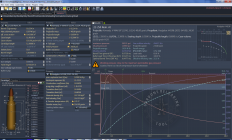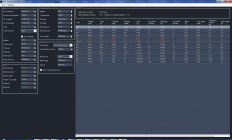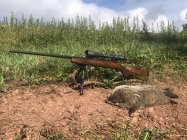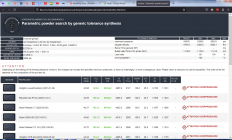Nice rackMy first prairie dog safari was in 1984. I hope to have enough experience some day to have a valid opinion.

You are using an out of date browser. It may not display this or other websites correctly.
You should upgrade or use an alternative browser.
You should upgrade or use an alternative browser.
Speed kills - 40 gr vs 53 gr in a 223
- Thread starter drover
- Start date
Regarding terminal performance, it’s a lot more involved than just the energy on paper at at a certain distance. As a more extreme example, a buddy of mine and I were shooting pdogs at a little over 700 yards. I had my 6mm BR shooting 69 gr Berger VLDs. My buddy was shooting his 22 Dasher loaded with 36 gr Varmint Grenades. There’s no doubt I had the ballistically superior bullet! Those VGs are about like shooting styrofoam from a ballistics perspective. We would switch back and forth shooting; one spotting for the other. There was an immense difference though when I would hit one at that range and when he would. I would knock them off their mounds and they would do the dying cockroach dance. He would hit them and they would get blown 10’-20’ off their mounds still partially vaporized - even at that distance. We still laugh about it when it comes up. (I had a bit higher percentage of hits though.) It’s much more about energy transfer. I was shooting target bullets and he was shooting bullets containing compressed powdered tin/copper. Those things dump all their energy into whatever they hit. I met the guy who designed them. He had a pharmacy background and used the same techniques for press forming pills applied to the cores of the VG bullets.
Last edited:
What twist rate is he using on the 55s and you on the 40s?l'm always interested what others shoot. For me, lts a learning experience.
Referencing 'light vs heavy'- l love 40s. My long time pd buddy Larry loves 55s. He points out he can shoot FURTHER. l have little interest in 'further'. lnside 250yds his 55s will knock chunks from a PD. My 40s will cut that same dog in HALF
If he keeps at it someday he could have a valid opinion.Nice rack
How fast was he shooting the 36gr and what twist rate?Regarding terminal performance, it’s a lot more involved than just the energy on paper at at a certain distance. As a more extreme example, a buddy of mine and I were shooting pdogs at a little over 700 yards. I had my 6mm BR shooting 69 gr Berger VLDs. My buddy was shooting his 22 Dasher loaded with 36 gr Varmint Grenades. There’s no doubt I had the ballistically superior bullet! Those VGs are about like shooting styrofoam from a ballistics perspective. We would switch back and forth shooting; one spotting for the other. There was an immense difference though when I would hit one at that range and when he would. I would knock them off their mounds and they would do the dying cockroach dance. He would hit them and they would get blown 10’-20’ off their mounds still partially vaporized - even at that distance. We still laugh about it when it comes up. (I had a bit higher percentage of hits though.) It’s much more about energy transfer. I was shooting target bullets and he was shooting bullets containing compressed powdered tin/copper. Those things dump all their energy into whatever they hit. I met the guy who designed them. He had a pharmacy background and used the same techniques for press forming pills applied to the cores of the VG bullets.
I'll have to try some of those V Grenades.
I don’t know the exact velocity. I’m sure they were over 4k fps though. I would have to ask him about the twist rate. Probably 12 or 14 though. It was built using one of Stiller’s prototype actions. Pretty cool gun!How fast was he shooting the 36gr and what twist rate?
I'll have to try some of those V Grenades.
"I were shooting pdogs at a little over 700 yards"I don’t know the exact velocity. I’m sure they were over 4k fps though. I would have to ask him about the twist rate. Probably 12 or 14 though. It was built using one of Stiller’s prototype actions. Pretty cool gun!
Is that a typo? A 36gr VG was able to Blow up a PD at 700 yards? I thought the blow ups were all inside 250 yards. That is impressive if correct.
I didn’t think so either and that’s how it started was on a bet. My buddy used to shoot competitively though with some pretty big names in TX. He’s a great shooter."I were shooting pdogs at a little over 700 yards"
Is that a typo? A 36gr VG was able to Blow up a PD at 700 yards? I thought the blow ups were all inside 250 yards. That is impressive if correct.
sw282
Silver $$ Contributor
Regarding terminal performance, it’s a lot more involved than just the energy on paper at at a certain distance. As a more extreme example, a buddy of mine and I were shooting pdogs at a little over 700 yards. I had my 6mm BR shooting 69 gr Berger VLDs. My buddy was shooting his 22 Dasher loaded with 36 gr Varmint Grenades. There’s no doubt I had the ballistically superior bullet! Those VGs are about like shooting styrofoam from a ballistics perspective. We would switch back and forth shooting; one spotting for the other. There was an immense difference though when I would hit one at that range and when he would. I would knock them off their mounds and they would do the dying cockroach dance. He would hit them and they would get blown 10’-20’ off their mounds still partially vaporized - even at that distance. We still laugh about it when it comes up. (I had a bit higher percentage of hits though.) It’s much more about energy transfer. I was shooting target bullets and he was shooting bullets containing compressed powdered tin/copper. Those things dump all their energy into whatever they hit. I met the guy who designed them. He had a pharmacy background and used the same techniques for press forming pills applied to the cores
Standard Remington 700 223s. Mine Was an old Heavy Varmint, 1-12". He has a couple old Senderos in 223. He had one rebarreled by Shilen a few years back. l think both are one-in-twelve.What twist rate is he using on the 55s and you on the 40s?
Is this pic from 1984?My first prairie dog safari was in 1984. I hope to have enough experience some day to have a valid opinion.

alf
Silver $$ Contributor
Mid to late 2000's.......Is this pic from 1984?
How about taking that one step further? Neck it down to a 20. Your 40gr bullet goes from a BC of about 200 (in 22) to 275! Should hold onto the flatter curve farther for the same amount of powder. Shot 22-250 back in the day and favored the 50 to 53 gr bullets at 3800 to 4000. Outside that (below or above) it needed different twist depending on which way you went. My most accurate was Speer 52grSP and Hornady 53gr HP at just under 3900fps. Bust chucks at 300yd with authority.
In my 26" bolt 223 with a silent 1:12, 25.8 gr benchmark with a 53 vmax or varmageddon gives 3350 fps....no signs of pressure. Work up to this load.If any of you have ready my replies to PD bullets you have likely noticed that I am a proponent of the 40 gr bullets for PD shooting - here is the reason I favor the 40 gr over the 50/53 gr bullets.
Below are the JBM ballistic charts comparing them - it is obvious that the 40 gr does not give up anything significant to the 53 and in most instances the 40 gr bests the 53
3700 fps out of the 223 with 40 gr is obtainable with numerous powders.
3000 fps out of the 223 with 50/53 gr bullets is the top velocity with most powders only attaining 2850 - 2900 fps.
These are not "pie in the sky" figures - the 3700 and 3000 fps are from load data from reloading manuals. These calculations are top velocity with both bullets.
The 40 gr Nosler has less drop, drift figures are essentially comparble, energy figures favor the 40 gr out to 300 yds and then slightly shifts in favor of the 53 gr but so little as to be insignificant.
Recoil differences between the 40 and 53 is negligible but is slightly in favor of the 40 which may make a difference on a high volume day.
40 gr Nosler ballistic tip @ 3700 fps - 10 mph wind
53 gr Hornady V-Max @ 3000 fps - 10 mph wind
40 gr Nosler ballistic tip recoil - 9# rifle
Charge Weight: Muzzle Velocity: Firearm Weight: Bullet Weight: Recoil Velocity: Recoil Energy: Recoil Impulse:
53 gr Hornady V-Max recoil - 9# rifle
Charge Weight: Muzzle Velocity: Firearm Weight: Bullet Weight: Recoil Velocity: Recoil Energy: Recoil Impulse:
27 gr h335 with a 40 gr vmax gives 3740
Gary in MD
Gold $$ Contributor
AckleymanII
Gold $$ Contributor
Drover, I am shooting the 53's at 3400+ with a heavy charge of Benchmark, cCi 450's in a 24", 12T remington factory barrel.
40's run out of gas around 275 yards where the dogs just fall over, not to mention how they blow like a kite in the wind.
40g in a 9Twist at short range are impressive. Every see a dog detonate and watch the pieces parts rotate like the barrel twist?
40's run out of gas around 275 yards where the dogs just fall over, not to mention how they blow like a kite in the wind.
40g in a 9Twist at short range are impressive. Every see a dog detonate and watch the pieces parts rotate like the barrel twist?
Similar threads
- Replies
- 15
- Views
- 2,804
- Replies
- 12
- Views
- 6,439
Upgrades & Donations
This Forum's expenses are primarily paid by member contributions. You can upgrade your Forum membership in seconds. Gold and Silver members get unlimited FREE classifieds for one year. Gold members can upload custom avatars.

Click Upgrade Membership Button ABOVE to get Gold or Silver Status.
You can also donate any amount, large or small, with the button below. Include your Forum Name in the PayPal Notes field.
To DONATE by CHECK, or make a recurring donation, CLICK HERE to learn how.

Click Upgrade Membership Button ABOVE to get Gold or Silver Status.
You can also donate any amount, large or small, with the button below. Include your Forum Name in the PayPal Notes field.
To DONATE by CHECK, or make a recurring donation, CLICK HERE to learn how.













